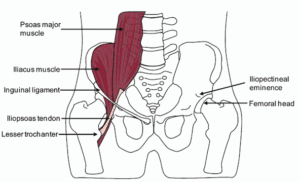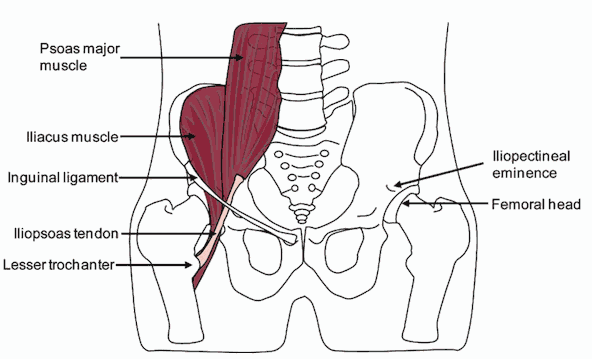We often take our muscles for granted until they start causing discomfort or pain. One such muscle that can be a source of pain is the iliacus muscle. This deep-seated muscle plays a crucial role in stabilizing the hip and allowing us to perform various movements. In this article, we will delve into the world of the iliacus muscle, exploring its anatomy, functions, common causes of pain, symptoms, diagnosis, treatment options, and preventive measures.
Contents
What is the Iliacus Muscle?
The iliacus muscle is a flat, triangular muscle located in the pelvis. It lies deep within the abdominal region and plays a dynamic role in hip movement. Together with the psoas major muscle, it forms the iliopsoas muscle group, often referred to as the hip flexors. This muscle group is responsible for flexing the hip joint, allowing us to lift our legs, walk, run, and engage in various physical activities.
The iliacus muscle originates from the iliac fossa, a concave surface of the pelvis, and extends down to its insertion point in the femur, or thighbone. Its proximity to the hip joint makes it a vital muscle for maintaining hip stability and proper alignment.
Function and Role of the Iliacus Muscle

The iliopsoas muscle is the primary muscle responsible for flexing the hip joint, allowing us to lift our knees towards our chest or to perform movements like walking, running, and climbing stairs.
The function of the Iliacus Muscle:
- Hip Flexion: The main function of the iliacus muscle is to flex the hip joint. When the muscle contracts, it pulls the thigh bone (femur) upward toward the abdomen, resulting in hip flexion.
- Stabilization: The iliacus muscle, along with the psoas major, provides stability to the lumbar spine and the hip joint during various movements. It plays a crucial role in maintaining proper posture and preventing excessive sway or hyperextension of the lower back.
- Assists in Lumbar Spine Flexion: Apart from its role in hip flexion, the iliacus muscle also contributes to the forward bending of the lumbar spine.
Role in Activities: The iliacus muscle is involved in a variety of activities that require hip flexion or lumbar spine flexion, including:
- Walking and Running: When you lift your leg off the ground during walking or running, the iliacus muscle contracts to flex the hip joint and move the leg forward.
- Climbing Stairs: The iliacus muscle is essential for raising the leg to ascend stairs or any inclined surface.
- Cycling: During cycling, the iliacus muscle is engaged to lift the legs upward and push the pedals forward.
- Sitting Up from a Lying Position: When you sit up from a lying position, the iliacus muscle helps in lifting the upper body by flexing the hip joint.
- Core Exercises: The iliacus muscle is also involved in various core exercises that require hip flexion, such as leg raises or certain Pilates movements.
Causes of Iliacus Muscle Pain
Iliacus muscle pain can result from various factors and conditions. Some common causes of iliacus muscle pain include:
- Muscle Strain: Overexertion or sudden movements can lead to muscle strain in the iliacus muscle. This may occur during activities that involve repetitive hip flexion or excessive force on the muscle.
- Muscle Imbalance: Imbalances between the iliacus and other hip muscles can lead to increased strain on the iliacus muscle, resulting in pain and discomfort.
- Psoas Syndrome: The iliacus muscle works in conjunction with the psoas major muscle, and together they form the iliopsoas complex. Psoas syndrome, which is characterized by tightness or inflammation of the psoas muscle, can also affect the iliacus muscle and lead to pain.
- Hip Joint Issues: Problems in the hip joint, such as osteoarthritis or labral tears, can cause referred pain in the iliacus muscle.
- Muscle Trigger Points: Trigger points are hyperirritable spots within the muscle that can cause local pain or refer pain to other areas. Trigger points in the iliacus muscle can result from overuse, muscle tension, or poor posture.
- Muscle Tension and Overuse: Prolonged sitting or activities that involve repetitive hip flexions, such as cycling or running, can cause muscle tension and overuse, leading to pain in the iliacus muscle.
Symptoms of Iliacus Muscle Pain
Iliacus muscle pain can manifest with various symptoms, and these may vary from person to person depending on the underlying cause and severity of the condition. Some common symptoms of iliacus muscle pain include:
- Localized Pain: Pain is typically felt in the front part of the hip, close to the groin area. The pain may be sharp, dull, or achy, and it can range from mild to severe.
- Pain with Hip Flexion: Pain in the iliacus muscle is often exacerbated by movements that involve hip flexion, such as lifting the knee towards the chest or bending forward at the hip.
- Radiating Pain: In some cases, iliacus muscle pain may radiate to other areas, such as the lower back, buttocks, or down the front of the thigh.
- Stiffness and Reduced Range of Motion: Tightness and stiffness in the hip joint and surrounding muscles, including the iliacus, may lead to a reduced range of motion in the hip.
- Tenderness: The affected area may feel tender to touch, and there might be localized areas of increased sensitivity.
- Muscle Spasms: Some individuals may experience muscle spasms in the iliacus muscle, causing involuntary contractions and increased discomfort.
Diagnosis Methods
When you experience symptoms suggestive of iliacus muscle pain, it’s essential to seek medical evaluation for an accurate diagnosis. A healthcare professional, such as a physician or a physical therapist, will typically perform a comprehensive assessment to determine the underlying cause of the pain. The diagnostic process may include:
- Medical History: The healthcare provider will inquire about your symptoms, the onset and duration of pain, and any relevant medical history or activities that might have contributed to the pain.
- Physical Examination: A thorough physical examination will be conducted to assess the hip and surrounding areas for tenderness, range of motion, muscle strength, and any signs of inflammation or muscle imbalance.
- Imaging Studies: In some cases, imaging tests such as X-rays, MRI (Magnetic Resonance Imaging), or ultrasound may be ordered to rule out other potential causes of hip pain and to visualize the soft tissues and structures in the hip region.
- Diagnostic Injections: Occasionally, diagnostic injections, such as local anesthetics or corticosteroids, may be used to confirm that the pain is originating from the iliacus muscle or the surrounding area.
Stretching and Strengthening Exercises for Iliacus Muscle Pain Treatment

Stretching and strengthening exercises can be beneficial in managing and preventing iliacus muscle pain. These exercises help improve flexibility, reduce muscle tightness, and strengthen the hip and surrounding muscles, promoting better hip function and stability. Here are some effective stretching and strengthening exercises for the iliacus muscle and the hip region:
Stretching Exercises
Iliacus Stretch:
- Start in a kneeling lunge position with one knee on the ground and the other foot forward, forming a 90-degree angle.
- Tuck your pelvis under and gently push your hips forward, feeling a stretch in the front of the hip of the kneeling leg.
- Hold the stretch for 20-30 seconds, then switch to the other leg.
- Perform 2-3 repetitions on each side.
Pigeon Pose:
- Begin in a tabletop position (on your hands and knees).
- Bring one knee forward and place it behind the corresponding wrist.
- Slide the other leg straight back, keeping the hips squared.
- Lower your upper body down towards the floor, feeling a stretch in the hip of the front leg.
- Hold the stretch for 20-30 seconds, then switch to the other leg.
- Perform 2-3 repetitions on each side.
Strengthening Exercises
Hip Flexor Strengthening
- Lie on your back with one knee bent and the foot flat on the floor, and the other leg straight.
- Lift the straight leg off the ground a few inches while engaging the abdominal muscles to stabilize the pelvis.
- Hold for 5-10 seconds and then lower the leg back down.
- Perform 10-15 repetitions on each leg.
Bridge Exercise
- Lie on your back with both knees bent and feet flat on the floor, hip-width apart.
- Lift your hips toward the ceiling, creating a straight line from your shoulders to your knees.
- Squeeze your glutes and hold the bridge position for 5-10 seconds.
- Lower your hips back down to the starting position.
- Perform 10-15 repetitions.
Clamshell Exercise
- Lie on your side with your knees bent, keeping your feet together.
- Keeping your feet together, lift the top knee upward while keeping the hips stacked.
- Lower the knee back down without allowing the pelvis to roll backward.
- Perform 10-15 repetitions on each side.
Prevention and Self-Care

Preventing iliacus muscle pain and taking good care of your hip and lower back region can help reduce the risk of developing discomfort and promote overall musculoskeletal health. Here are some preventive measures and self-care practices to consider:
- Maintain Good Posture: Pay attention to your posture, whether you’re sitting, standing, or walking. Avoid slouching and try to keep your spine aligned in a neutral position.
- Take Regular Breaks from Sitting: If you have a sedentary job or spend extended periods sitting, make a habit of taking short breaks to stand up, stretch, and move around. This helps reduce the strain on your hip muscles.
- Warm Up Before Exercise: Before engaging in any physical activity, warm up your muscles with dynamic stretching or light aerobic exercises to increase blood flow and prepare your hip muscles for movement.
- Proper Lifting Technique: When lifting heavy objects, use proper lifting techniques to avoid putting excessive stress on your hip and back muscles. Bend at the knees and hips, not the waist, and keep the object close to your body.
Conclusion
The iliacus muscle, a vital player in hip flexion and stability can become a source of pain due to various factors such as sedentary lifestyles, overuse, and injuries. Understanding the causes, symptoms, and treatment options for iliacus muscle pain is essential in managing and preventing discomfort in this crucial muscle group. By adopting proper self-care practices and seeking timely medical attention, individuals can enjoy improved mobility and lead pain-free life.
If you’re experiencing Back pain, physical therapy for back pain at PhysioMantra can help: Book an online physical therapy session.



